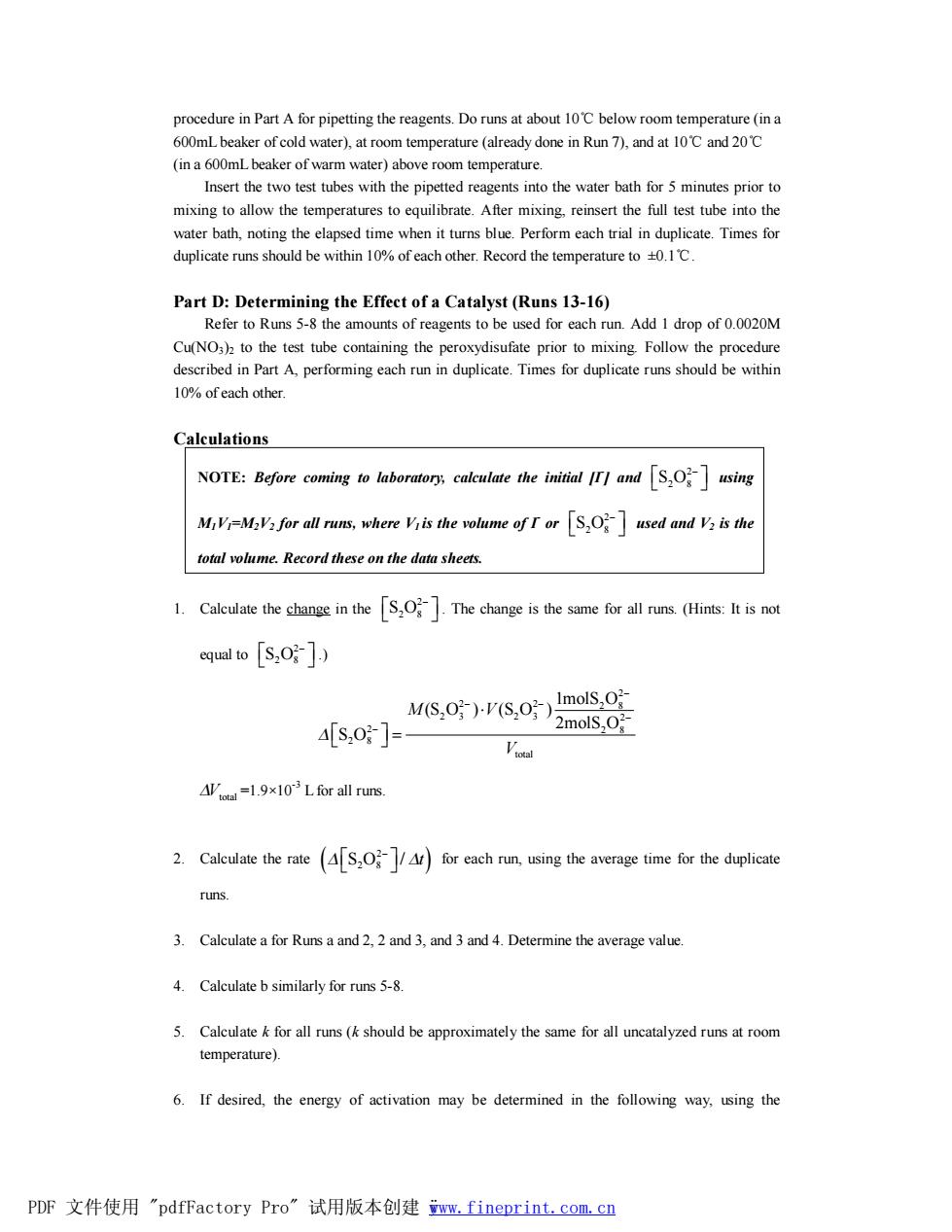正在加载图片...

600mLbea er of cold water),at room temperature (already done in Run 7),and at 10C and 20C (in a 600mL beaker of warm water)above room temperature. Insert the two test tubes with the pipetted reagents into the water bath for 5 minutes prior to mixing to allow the temperatures to equilibrate.After mixing,reinsert the full test tube into the vater duplicate runs sh Part D:Determining the Effect of a Catalyst(Runs 13-16) Refer to Runs 5-8 the amounts of reagents to be used for each run.Add 1 drop of .0020M Cu(NO to the test tube containing the peroxydisufate prior to mixing Follow the procedure e runs should be within Calculations NOTE:Before coming to laboratory,calculate the initial and S,using M:V;=M:V:for all runs,where V,is the volume of r or S,O used and V:is the total vlume.Record these on the data sheets. 1.Calculate the change in theS.The change is the same for all runs.(Hints:It is not equal to SO) M((.ImoIS,O 4[S,0g1= 2molS.O2 AV=1.all runs 2.Calculate the rate SOA for each run,using the average time for the duplicate runs. 3.Calculate a for Runs a and 2,2 and 3,and 3 and 4.Determine the average value. 4.Calculate b similarly for runs 5-8 5.Calculatek for all runs(k should be approximately the same for all uncatalyzed runs at room temperature). 6.If desired,the energy of activation may be determined in the following way,using the PDF文件使用"pdfFactory Pro”试用版本创建ww,fineprint.com,cnprocedure in Part A for pipetting the reagents. Do runs at about 10℃ below room temperature (in a 600mLbeaker of cold water), at room temperature (already done in Run 7), and at 10℃ and 20℃ (in a 600mLbeaker of warm water) above room temperature. Insert the two test tubes with the pipetted reagents into the water bath for 5 minutes prior to mixing to allow the temperatures to equilibrate. After mixing, reinsert the full test tube into the water bath, noting the elapsed time when it turns blue. Perform each trial in duplicate. Times for duplicate runs should be within 10% of each other. Record the temperature to ±0.1℃. Part D: Determining the Effect of a Catalyst (Runs 13-16) Refer to Runs 5-8 the amounts of reagents to be used for each run. Add 1 drop of 0.0020M Cu(NO3)2 to the test tube containing the peroxydisufate prior to mixing. Follow the procedure described in Part A, performing each run in duplicate. Times for duplicate runs should be within 10% of each other. Calculations 1. Calculate the change in the 2 S O2 8 - é ù ë û . The change is the same for all runs. (Hints: It is not equal to 2 S O2 8 - é ù ë û .) 2 2 2 2 8 2 3 2 3 2 2 2 8 2 8 total 1molS O (S O ) (S O ) 2molS O S O M V V D - - - - - × é ù = ë û DVtotal =1.9×10-3 Lfor all runs. 2. Calculate the rate ( ) 2 D D S2 8 O / t - é ù ë û for each run, using the average time for the duplicate runs. 3. Calculate a for Runs a and 2, 2 and 3, and 3 and 4. Determine the average value. 4. Calculate b similarly for runs 5-8. 5. Calculate k for all runs (k should be approximately the same for all uncatalyzed runs at room temperature). 6. If desired, the energy of activation may be determined in the following way, using the NOTE: Before coming to laboratory, calculate the initial [I- ] and 2 S O2 8 - é ù ë û using M1V1=M2V2 for all runs, where V1 is the volume of Ior 2 S O2 8 - é ù ë û used and V2 is the total volume. Record these on the data sheets. PDF 文件使用 "pdfFactory Pro" 试用版本创建 ÿwww.fineprint.com.cn